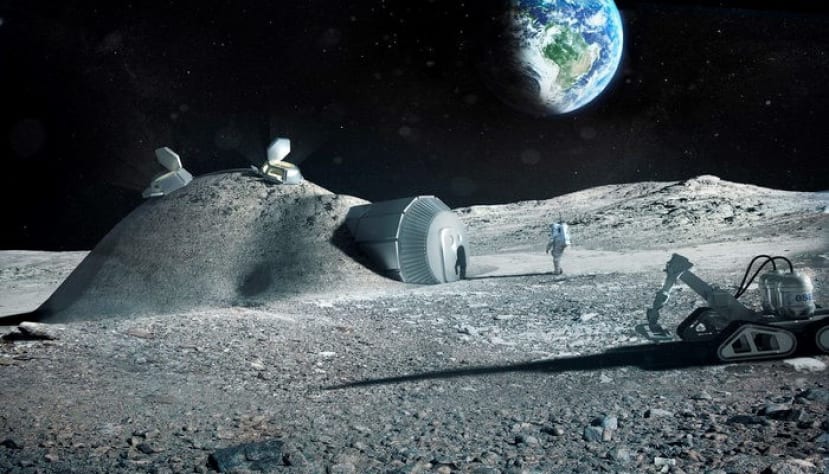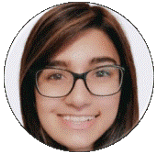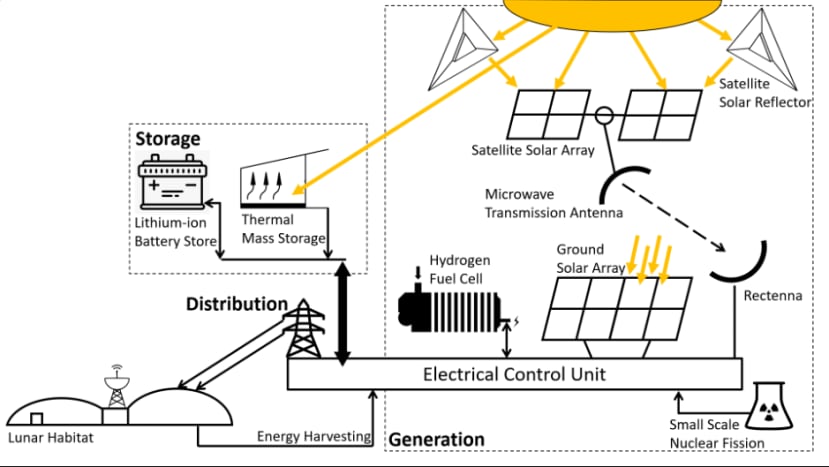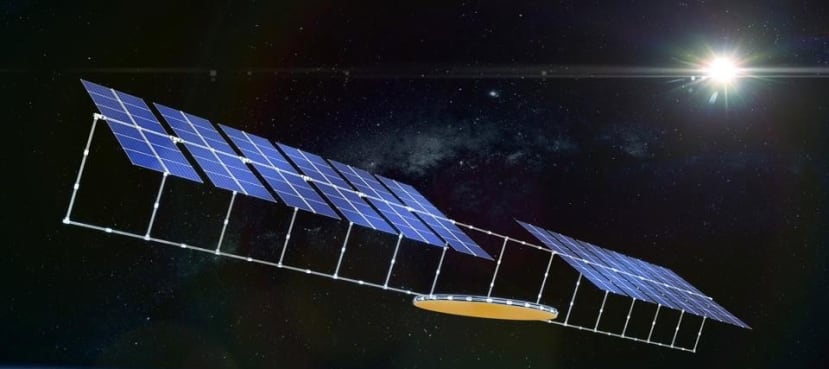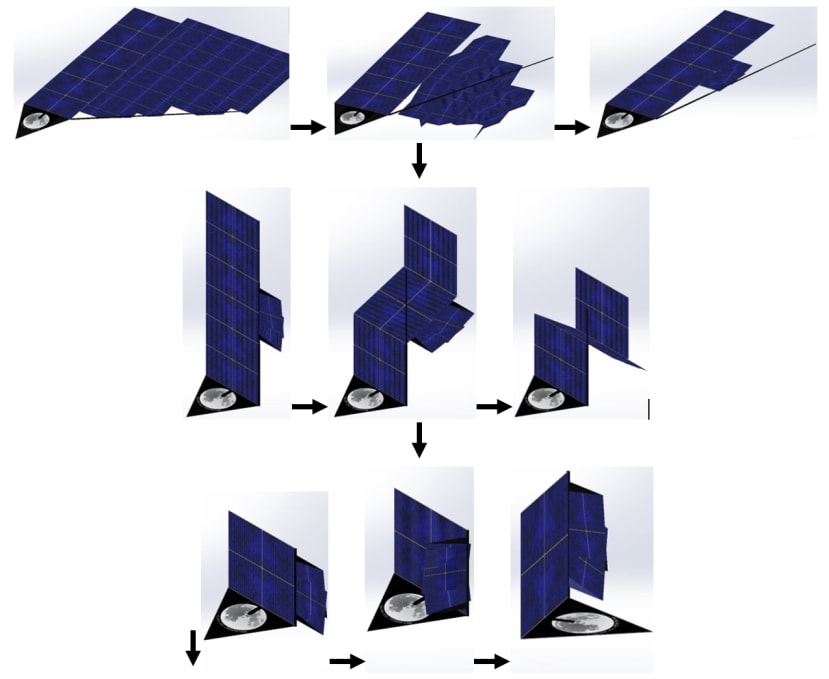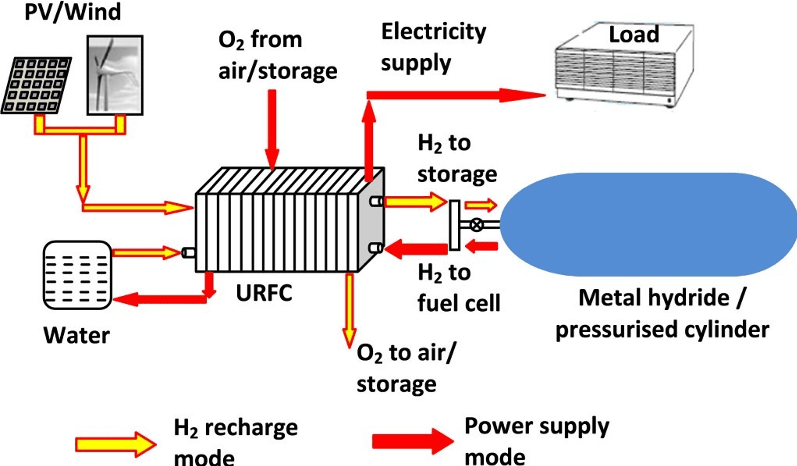Strathclyde Students Enter IGLUNA Design Challenge.
Follow articleHow do you feel about this article? Help us to provide better content for you.
Thank you! Your feedback has been received.
There was a problem submitting your feedback, please try again later.
What do you think of this article?
Who are we?
We are a team of 5th and 4th year Engineering Students from the University of Strathclyde. As part of our collective final year project, we have entered the 2021 IGLUNA Design Campaign. Our challenge is to design a resilient power generation, storage, and distribution system which meets the demands of a lunar habitat.
Last year, PowerHab delivered innovative concepts for power generation and storage, but this year we want to take it to the next step. This year, PowerHab will concentrate on establishing and advancing the Solar Power Satellites, Reflector Satellites, Fuel Cell, Thermal Mass, and Nuclear Energy sub-systems.
Why?
A manned lunar base is an important step in the advancement of space exploration and could prove the feasibility of sustaining human life on other worlds. For a lunar base to be useful, it should be a suitable environment for astronauts to live within and provide a base from which experiments can be carried out. All aspects of an efficacious lunar habitat require power, and the ultimate success of a manned mission relies on the resilience of our design.
What is IGLUNA?
IGLUNA 2021 is an international project spearheaded by the Swiss Space Centre in collaboration with the European Space Agency. The initiative brings students together in a united goal to design and develop subsystems as part of a prospective lunar habitat. The purpose of this mission is to demonstrate technologies capable of supporting a manned Lunar base, incorporating remote operation. For the 2020 edition, over 150 students organised in 19 teams across 13 European universities worked on developing a human habitat in ice. Each team focused on a specific aspect of the habitat, combining to produce a long-term solution for human-Lunar habitation.
Meet the Team.
Take a look at our intro video bleow! Created by our resident Spielberg, Adam Porteous!
 |
Name: |
Calum Mackintosh |
|
Responsibility: |
Team Leader |
|
|
Current education: |
MEng Mechanical Engineering |
|
|
Other interests: |
Mountaineering, Kayaking, Skiing |
|
|
Name: |
Eilidh Smyth |
|
Responsibility: |
Wireless Power Transmission |
|
|
Current education: |
MEng Mechanical Engineering |
|
|
Other interests: |
Triathlon, Hiking, Music |
|
|
Name: |
Nathaniel Cutler |
|
Responsibility: |
Solar Power Satellite Designer |
|
|
Current education: |
MEng Mechanical Engineering |
|
|
Other interests: |
Kayaking, Football |
|
|
Name: |
Adam Porteous |
|
Responsibility: |
Power Storage Engineer |
|
|
Current education: |
MEng Mechanical Engineering |
|
|
Other interests: |
Kayaking, Football |
|
|
Name: |
Ruaridh Summers |
|
Responsibility: |
Power Storage (Thermal Mass)/ Outreach and Sponsorship |
|
|
Current education: |
MEng Aero-Mechanical Engineering |
|
|
Other interests: |
Hillwalking, Kayaking, Skiing |
|
|
Name: |
Rory Cormack |
|
Responsibility: |
Power Storage Lead |
|
|
Current education: |
MEng Mechanical Engineering |
|
|
Other interests: |
Rugby, PC Building & Weightlifting |
|
|
Name: |
Emily Eadie |
|
Responsibility: |
Solar Powered Satellite / Treasurer |
|
|
Current education: |
MEng Mechanical Engineering |
|
|
Other interests: |
Mountaineering, Photography & Renewables |
|
|
Name: |
Mark McArthur |
|
Responsibility: |
Solar Reflector Satellites |
|
|
Current education: |
MEng Mechanical Engineering |
|
|
Other interests: |
Maths, Strategy Games, Science Fiction |
|
|
Name: |
Sehar Raza |
|
Responsibility: |
Nuclear Energy System |
|
|
Current education: |
BEng Electrical & Mechanical Engineering |
|
|
Other interests: |
Bouldering, Exploring Nature, Musicals at the Theatre, Arts & Crafts |
Our Subsystem
The complete system overview for the PowerHab project is split into three distinct categories: generation, storage, and distribution. Within these broad categories are the sub-system developments which are the focus of the project.
Below, a conceptual diagram of our system is shown. This was created to give an overview of how each component will interact with the overall system.
Each system will be designed to work as part of the larger subsystem, but in order to factor in system redundancy, several components will have the ability to perform individually in order to maintain baseline power.
Clearly, a large portion of our energy is sourced from the sun, but due to the location of our lunar base, the lunar night is 52 hours long. As result, our focus on energy storage and non-solar power generation have been as important as our development of the solar power and reflector satellites. A breakdown of our system and a description of each component is presented below.
Solar Power Satellites
Solar Power Satellites (SPS) will be employed to harvest solar energy via Photovoltaic (PV) panels and then transmit it wirelessly to the lunar surface via microwave Wireless Power Transfer (WPT). This will form the primary energy input to the lunar habitat and will rely on a suitable orbit to maximise the solar exposure and minimise the losses during transmission. This will in turn work to reduce the number of required satellites and therefore the mass required to be launched from earth.
The WPT is composed of two circuits: the transmitter (located on the satellite) and the receiver (on the lunar surface). The transmitter will oscillate and amplify the DC power obtained by the solar panels and then be transmitted by the antenna. This will then be received by the patch antenna and the power will be passed through a rectifying circuit and low pass filter to prepare it for consumption by the habitat.
The orbit of the SPS will be determined by looking at the key requirements of the power delivery system. As the IGLUNA mission will be for an extended period, the perturbation effects are analysed in order to minimise the number of trim manoeuvres required to keep the SPS in the desired orbit. Therefore, a frozen lunar orbit will be identified and chosen for the SPS orbit as long as it fulfils the other orbital criteria, including but not limited to: time in view of a lunar base, eclipse times, revisit times and communication window with ground station on Earth. To model and optimise our orbit NASA’s open-source GMAT program will be implemented.
Solar Reflector Satellites
The central idea behind this subsystem is to create large reflective panels in orbit with the solar panel satellites in order to maximise the amount of sunlight incident on the panels. The deployment and unfolding sequence of the satellites shall be the focus of development for this sub-system as the technology behind Photovoltaic Panels is well established. The system will utilise an origami methodology to deliver effectively store and deploy the solar satellite array.
Each design is required to fold to the size of roughly a single panel with a central area for satellite control and communication equipment. The reflective sheet will be Mylar covered in a UV protected coating and a reflective coating. The satellite will deploy the reflective sheet by either; gas expansion in a fibre tube that has a resin which solidifies at the temperature of space, or telescopic extension with tensioning cords. Three deployment configurations are currently under consideration. First is an orthogonal expansion similar to the L’Garde Solar Sail which has proven effective. It is the simplest of the solutions as the reflective sheet is deployed by four expanding beams with no other moving parts and can be analysed in two-dimensions. Next is a triangular structure which unfolds along the edges before expanding to cover a much larger triangular area. The first fold is completed simply with telescopic beams, but the complexity is increased to cover the larger second step by utilising a ‘Miura Ori’ pattern, unfolding in three-dimensions. The final consideration is a hexagonal flasher design. Although the fold pattern is the most complex of the three, the unfolding sequence can easily be completed using just rotation of the central section. However, the supporting structure of this design may be more challenging to construct.
All designs are selected to be tessellating thus allowing for easier expansion if the power requirements are increased. This can also increase the operational lifespan of the satellite and further improve the energy generation to mass/volume trade-off.
The following initial renders have been produced during the concept generation for a triangular folding satellite deployment.
Proton Exchange Membrane Fuel Cell
The Proton Exchange Membrane (PEM) fuel cell is to be used as a backup power generation system during the 52 hours of lunar night at the Shackleton Crater. This system produces power by converting the chemical energy from the hydrogen and oxygen in air or compressed storage into water and electrical energy. A major benefit of a PEM fuel cell is the option to run the system in reverse as an electrolyser to produce hydrogen by switching the polarity of the cathode and anode.
The flow paths for this system are shown for the PEM fuel cell working as both a fuel cell to produce power and as an electrolyser to hydrogen.
PEM fuel cells utilise a stacked system. This allows for the system to be expanded for increased power demands. While also allowing for easier maintenance and upkeep as each stack can be worked on individually. In a PEM fuel cell, there are three main cell components: Membrane Electron Assembly (MEA), Gas Diffusion Layer and Bipolar Plates.
The fuel cell design has completed our ‘conceive’ stage, and the next steps are based on the implementation and operation phases which will focus on the manufacture of the prototype fuel cell. The fuel cell will be under different operating conditions to optimise the system for highest efficiency and reliability.
Nuclear Energy
Due to the limitations and scope of this project, the development of the nuclear power systems will be solely conceptional and no physical prototype will be produced.
Nuclear fission is a new energy generation system being explored for the PowerHab system. Nuclear reactors have been identified as a promising source for energy generation in space by many researchers. This is because a nuclear energy system offers high-power density and a constant energy source. Compared to solar energy, nuclear reactors are not limited by the Moon’s dark days or deep craters that can block the Sun; the reactors also do not need to use energy systems which have limited lifespans and will increase the mass and cost of the system. Therefore, a nuclear energy system has the potential to increase the reliability and efficiency of the overall system.
Thermal Energy Storage
The purpose of the Thermal Mass is to store generated energy so it can be kept and repurposed at a later date. The stored heat energy could be used to maintain ambient storage conditions for separate subsystems and components – a warm store for lunar rovers has been considered and will be discussed with the other relevant IGLUNA teams. Repurposing the thermal energy into electrical potential, however, will be the main function of the Thermal Mass system. Using an arrangement of heat exchangers and a thermal engine, electrical energy will be produced and delivered back to the electrical control unit to be distributed to the lunar base microgrid. Below a graphical representation of the system is displayed.
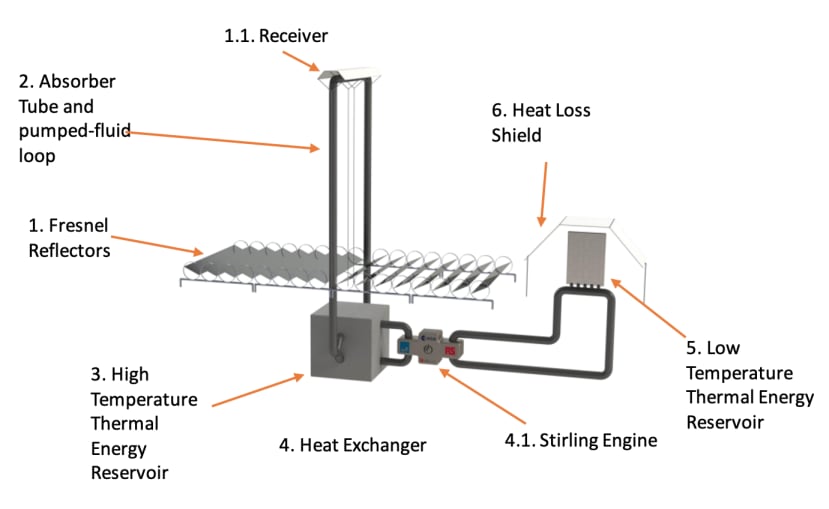
What’s Next?
Over the Christmas Break and coming months, we wish to finalize our prototype designs and start manufacturing basic components. Internally at Strathclyde, we will also present our work thus far in an interim presentation to update the faculty of our work. Outside of this, we will conduct further meetings with other teams from across Europe in order to discuss subsystem integration and project development. We will be posting further updates to this website as the project progresses so make sure to stay tuned!
Thank you for taking the time to read this article,
Ruaridh Summers
PowerHab | IGLUNA 2021,
Energy Storage Engineer/ Outreach
MEng Aero-Mechanical Engineering

